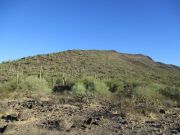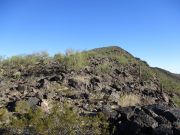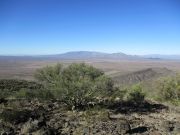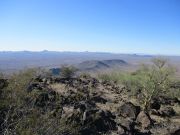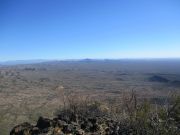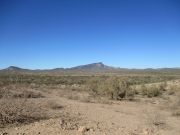
The Mountains of Arizona
• www.surgent.net
|
| Black Butte |
• Hassayampa Plain • Vulture Mountains (outlier) • Bureau of Land Management • Maricopa County |
|
Date: November 28, 2021
• Elevation: 3,612 feet
• Prominence: 1,092 feet
• Distance: 8.1 miles
• Time: 5 hours
• Gain: 1,580 feet
• Conditions: Sunny and clear, cold at start, warm later
• Teammate: Matthias Stender
Arizona
•
Main
•
AZ P1K
•
PB
•
LoJ
•
USGS BM Datasheet
Black Butte is a volcanic formation in the deserts west of the White Tank Mountains, north of the Belmont Mountains, and southwest of the Vulture Mountains. In other words, close to nowhere. It stands out because of its shape and composition. It is much higher than its surrounding peaks and is covered in black basalt boulders, contrasting against the lighter tones of just about everything around it. Matthias and I were interested in it, but wanted to wait until things cooled a bit. This weekend looked promising, so we went for it.
We met at 6 a.m. at the Wal-Mart off Dysart Avenue in Goodyear, then I drove us westbound on Interstate-10 to the 339th Avenue Exit, north to Indian School, west a couple miles to 355th Avenue, and followed that about 25 miles north and northwest into the hinterlands to where it comes to a lonely four-way intersection with Vulture Mine Road, coming in from Wickenburg. I continued northwesterly, the road now called Aguila Road. It is dirt now but wide and graded so I could usually go 40 miles per hour without any trouble. Black Butte was in view, shaped like a big skewed triangle, its long sloping side to our left, a steeper side to our right.
I did not track mileage, but it was about 12 miles on Aguila Road to a meager turnout shown on the topographical map, running partly beneath power lines (for reference, one could simply stay on Aguila Road until it passes beneath the power lines and catch the road there).
My hope was that this road would not be too rough and that I could shave off some miles if I could drive in on it. I was mentally prepared to walk it if necessary. The road turned out to be pretty good. It paralleled the power lines briefly, then swung north then northeast. I stayed on it as long as it felt comfortable to do so. I lucked out and was able to drive in a full two miles on it. This would shave off 4 miles and a couple of hours of hiking. I parked on a bluff overlooking an arroyo. It was about 7:40 when we got situated and started on our hike.
We walked the road downhill into the arroyo, then up the other side, then past an earthen tank that was completely dry. The road continued past the tank (the road not shown on the map), but grew weaker and rougher. I could have nursed my Forester past the tank, but not much farther. But for walking, it was dandy. We stayed on the road as long as possible until it fed us into another arroyo, which we followed northbound (and angling northwest) for about a quarter-mile. Another track cuts across the arroyo, so we exited the arroyo onto the track, followed it, then back into the arroyo for a little bit, then up its other side. We were now roughly a mile east of Black Butte, which stood grandly in front of us.
We walked this new track westbound for a mile, until we were at the south toe of the long southern ridge. Once there, we exited the road and started up this ridge, which would gain about 1,200 feet in a mile to the summit.
Now we were hopping on the basalt bulders nearly the whole way. Sometimes they were steep and some moved, and other times we had to use hands to scale a heap of the boulders. Then things would flatten slightly and we had regular ground to walk on, until the boulders started up again. There was plenty of brush and cactus, and more ocotillo than usual, and palo verde and saguaro to break up the monotony. But the brush wasn't thick and we could walk around it whenever necessary.
This uphill slog presented no issues; it was just a matter of walking it until we were at the top. There were a couple false summits, but we were expecting this. We were on top at 10 a.m. almost on the nose. Almost all of our gain had been on this long uphill on the mountain itself, and Matthias said we'd covered just over 4 miles.
We took a long break up top. Conditions were superb. The benchmark was easily found as was one reference marker. We had a 360-degree panorama of mountains and deserts. It was slightly misty/hazy east toward Phoenix, but we could make out peaks a long distance away, such as Woolsey and Table Top to the southeast, the Weavers and Bradshaws to the north, and the Little Horns and Kofas to the southwest. Closer in were the Harquahalas, the Harcuvars, the Belmonts, the Vultures and the White Tanks. I was able to identify 25 peaks in view that I have previously climbed. That means two things: (1) I've been here too long, and (2) I have no life. Yes, this was a nice summit, nicer than usual.
We hiked down exactly the same way. Within 45 minutes we were back on the flats south of the peak, then we just walked the track, the arroyo, and the other track back to my car, arriving at 11:45 a.m.. By now, it had warmed into the 70s, but it was a beautiful blue-bird afternoon. We got changed and I slowly drove us back to pavement and to Interstate-10. However, I stopped in at the TA Truck Stop on 339th Avenue for snacks. I always stop there. In 1992, I stopped there for drinks on the day I moved to Arizona, one scaldingly hot August afternoon (113°), so I drop in when I can. Today, it was jam-packed with travellers, today being the Sunday after Thanksgiving. Traffic into Phoenix wasn't too nasty, and I was able to get Matthias dropped off, and me home, in reasonable time.
Today's climb had been especially enjoyable, in that the logistics turned out perfectly for us. I was tickled to drive in on that side road for 2 miles, and that the hike was mostly on tracks and arroyo, so that avoiding brush was mitigated. The uphill climb went well, and the views from the top were worth the effort. Everything worked out nicely today. My thanks as always to Matthias for the companionship.
|
|


